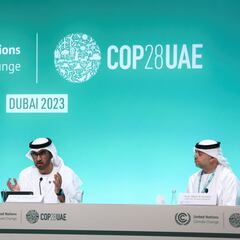Climate Conference 2024: what does COP stand for anyway?
As we reach the end of the year, another meeting takes place determined to find common climate change causes to create firm international agreements.


Whether it’s the UNFCCC, NDCs or indeed the oft-used title of COP, when it comes to climate change negotiations there are a lot of acronyms and initialisms that can confuse the occasionally interested news observer. And with the world converging its focus on COP28, with a reported 70,000 delegates descending on the United Arab Emirates, it feels an opportune moment to delve into the significance of the term “COP” and some of the other names and terminologies that characterise the global discourse on climate change.
Unpacking COP: a global endeavour
COP stands simply for ‘Conference of the Parties’, and it represents the annual gathering of countries attempting to address the challenges of climate change. Originating from the UNFCCC, the COP meetings provide a platform for nations to collaboratively assess progress, negotiate new agreements, and set collective goals to combat climate change. This crucial international forum plays a pivotal role in shaping the trajectory of global efforts towards a sustainable and resilient future, with some invaluable work being done face-to-face in the back channels, something that many feel would be impossible in a virtual environment.
Find out all the details of COP28 at its official website.
I spoke to @BBCr4today about the new #LossAndDamage agreement, King Charles at #COP28 and what we need to achieve at this COP. Listen in full from 1:12:12 https://t.co/ISEPXOp7G1 pic.twitter.com/JuKiHN0Ktb
— Tom Rivett-Carnac (@tomcarnac) December 1, 2023
More COP terminology
UNFCCC - the bedrock
The United Nations Framework Convention on Climate Change (UNFCCC) serves as the foundation for COP meetings. Adopted in 1992, the UNFCCC aimed to address the environmental and socio-economic impacts of human-induced climate change. It laid the groundwork for subsequent COP meetings and established the principles guiding international climate action.
Each COP meeting is assigned a number, reflecting its chronological order. Notable milestones include COP3, which led to the Kyoto Protocol, and COP21, culminating in the historic Paris Agreement, although there have been many others. These agreements have significantly shaped the global response to climate change and underscore the evolving nature of COP discussions.
Paris Agreement
COP21, held in Paris in 2015, witnessed the landmark adoption of the Paris Agreement, which you’ve likely heard of. This accord outlined the commitment to limit global temperature rise to well below 2 degrees Celsius above pre-industrial levels, with efforts to pursue a more ambitious target of 1.5 degrees Celsius.
Despite its success in hosting the breakthrough COP21 summit of 2015, France has not lived up to those ideals. The country was one of the only EU member states to miss its renewable energy targets in 2020, as CGTN’s Rebecca Bundhun reports. pic.twitter.com/dNH2Noqh07
— CGTN Europe (@CGTNEurope) December 1, 2023
NDCs - Nationally Determined Contributions
NDCs (Nationally Determined Contributions) are commitments made by individual countries under the Paris Agreement, specifying their efforts to reduce greenhouse gas emissions and adapt to the impacts of climate change. These contributions vary based on each nation’s capacity and circumstances.
Adaptation and mitigation
Key concepts in the climate change lexicon, adaptation focuses on strategies to cope with and minimise the impacts of climate change, while mitigation involves efforts to reduce or prevent greenhouse gas emissions.
Humanity’s fate hangs in the balance.
— United Nations in India (@UNinIndia) December 1, 2023
Make this COP count.
Make this COP a gamechanger.
Make this COP the new hope in the future of humankind.
- @UN Secretery-General @antonioguterres's statement at the World Climate Action Summit at #COP28 . pic.twitter.com/2ooyjaNb5H
COP28: shaping the future?
Related stories
As COP28 unfolds, the international community faces the pressing task of building upon previous agreements and accelerating actions to address the urgent challenges posed by climate change. Day 1 certainly caused an excitable stir, with momemtum hoped for from the off by leaders in Dubai.
The names and terminologies embedded in the climate change discourse serve as markers of our collective commitment to a sustainable and resilient planet. But, as if often the case, it is the actions that will speak louder...

